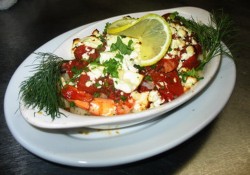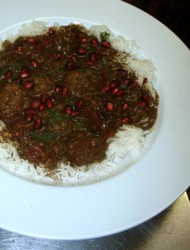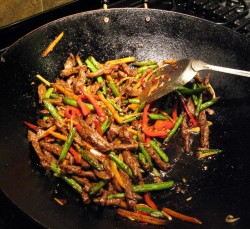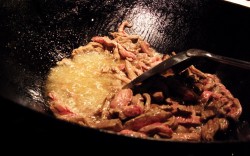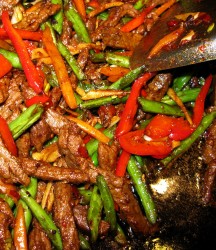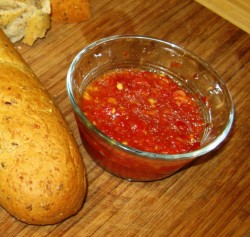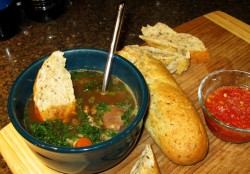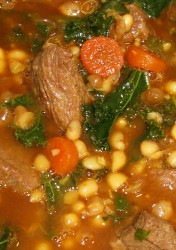What’s So Special About Dinner Specials?
One of the best parts of working as a chef is coming up with dinner specials.
It can also be one of the worst parts of being a chef.
On the one hand, it is a creative process, and that is always a good thing. Chefs like to flex their culinary imaginations, they like to do new things, and off-menu specials are a chance to shine creatively. These specials can be spontaneous or planned, but in either case, they let cooks and chefs stretch their wings and soar a bit, especially when much of restaurant work is repetitive, exacting, and face it–not thrilling. (No, really, cutting a case of onions at a time is not thrilling, fun, or glamorous. Or, wiping down walls at the end of the shift. Nope, not thrilling.)
That is the good part.
The bad part is that it is hard for a chef (especially one who is new on the job, like I am) to predict exactly what diners will want on any given night. If you add into that equation bad winter weather and unpredictable business because of fluctuating town population (meaning, Ohio University is on Christmas break and much of Athens’ population has left town for the holiday) you come up with a situation that can be frustrating.
However, instead of being frustrated, a good chef will turn it all around and see it as a challenge that can not only be surmounted, but can work to her advantage by providing a crass course in “Diner Psychology 101.”
I am still learning how to predict what Salaam’s guests will like and what they will not like. It is an inexact science–predicting people’s tastes–but I intend to at least learn how to tune my instincts into the wavelength upon which the diners of Athens reside.
For example–the dish pictured above–Greek Shrimp and Feta Casserole–sounded moderately interesting to me, but not overly exciting. I read a description of it in a book, and chose to do it because I thought that I could do it in individual casserole dishes, and I could make it pretty, while keeping the food cost low, because we pretty much had everything we needed on hand. (A good chef is always aware of food cost. Always.)
But what is weird, is I never thought it would be that tasty. I mean, I didn’t think it would taste bad–not at all, but it wasn’t something that I thought would be very flavorful. The original recipe, in fact, was kind of bland sounding, so admittedly, I jazzed it up some, and added some fresh herbs and flavorings that the description and recipe I read didn’t have. But still–it went together so simply, I figured it might not be that great.
I was wrong.
Several guests, after eating the dish, told me that it was one of the best things they had eaten recently. One woman enthused about how infused it was with flavor, and how it all went together beautifully.
I made a mental note of this, and when I got home, I opened up my laptop, and in my notebook where I keep records on the specials I run, I made note of the enthusiasm with which the shrimp were met.
Now, I know to run that recipe–or a similar one–again. (I say recipe as if I wrote one, or followed one. This is not true–I read a description of the dish online, and said, “Huh. I can do that,” and then off the top of my head, made it. But that is okay–I remember how it went and can recreate it at will. That is the delight of simple recipes–they can all live in one’s head for years without having to be codified.)
And then, there is the case of the Persian Pomegranate Soup.
Hilarie and Mark, the owners of Salaam, wanted me to run the soup as a special as soon as they read my post on it. I finally got around to it this weekend–I made it yesterday, only to find that it was ordered by only two people–one of whom, admittedly loved it–she went out of her way to tell me so. She particularly praised the tenderness of the meatballs–they are tender, of course, because they are simmered gently in the soup broth without being browned in a pan first.
But, for some reason–whether it was the description I gave of it to our servers, or whether to many guests’ ears, the words “pomegranate” and “soup” do not belong in the same sentence together–I will never know–the special did not sell.
That can be a problem, of course, because if you make food that no one wants and you end up throwing it out–it raises your food cost.
Raising the food cost is A Very Bad Thing. (That last sentence, written in capital letters, in bold typeface, in neon glowing letters, underlined, in 30 point type, is emblazoned in my memory from culinary school and my experience in every professional kitchen. I now have it in my nature to never, under any circumstances waste food, even if it is at home for fear of RAISING THE FOOD COST! So, I am a little paranoid about that issue.)
No chef worth her salt will throw out perfectly good food just because some folks think they don’t like it. It is much better, and it keeps the dreaded food cost beastie under control, to change it into something else–this is called repurposing.
So, rather than come up with an entirely new special for tonight, or running a completely failed special from the night before, I took the soup and changed it into something else.
First, I strained the meatballs, rice and split peas out of the broth, and saved the meatballs, discarding the other solids. I added tomatoes, sauteed onions and garlic and chicken broth to the soup, and brought it to a simmer. I then formed and the rest of the raw meatball mix I had on hand so that I could add meatballs to the soup this afternoon–the meatballs are quite tender, and I was worried if I put too many in the soup at once, I would end up breaking them up as I ladled them up to serve them. I figured I could always make more fresh. These new meatballs were then joined by the old meatballs in the soup broth, so that the old ones could heat up. Once they were at temperature, I put them in a holding pan to keep them warm, and went to work on the broth.
I reduced it by one third, and added some sugar to balance the very tart pomegranate flavor. I added more tomatoes, and reseasoned it considerably. Then, I thickened it, and added a bit of butter and half-and-half to mellow it out, and finally threw in a blast of chile heat to further balance the sour notes of the original broth. (Building or, as in this case, rebuilding, a sauce is a balancing act. It is a teeter-totter of the senses, and in the case of this soup, the flavor profile was way overbalanced towards sour. Sugar is an obvious remedy–if you say to someone what is the opposite of sour, most folks will say sweet. Chile, however, while it isn’t exactly a taste so much as a sensation, also helps balance strong tastes like sour by giving the tongue something else to experience.)
Over the meatballs the silky-smooth sauce went, and the dish was now something different–Persian Sweet and Sour Meatballs. Served over rice, and garnished with a generous handful of pomegranate seeds and fresh herbs, it was excellent. The entire staff tried it and declared it better than the traditional soup, and lo and behold, the public agreed–and ordered it gladly.
So, while the pomegranate soup may never appear on our tables again, the similar,yet different, meatballs probably will. (Though I will go about making it next time without going the long way around by making soup first and then making a pot of tender meatballs with kickass sauce. I’ll just make it straight up, with no forays into soupdom.)
It is a balancing act–pleasing the palates of people you have not met yet.
I guess it might help if I were psychic.
Maybe I should read Tarot cards before coming up with my dinner specials. It might help.
(Now that I think on it, card or palm reading would fit in with all the bellydance, Silk Road ambiance and exoticism that Salaam has to offer. Maybe I should mention it to Hilarie. Or not. Nope. Not. Definately not. A card reader would take a valuable table, and we’d have to feed him or her, which would raise the food cost….but it is still a kind of funny thought. But then, I am easily amused.)
The special this week I was most worried about turned out to be quite popular indeed.
I made a very modified version of my Chicken Vindaloo with Mango that included coconut milk–a somewhat traditional variation on my usual way of making it, and I was worried it would be too spicy with chile or mustard heat for our guests. Now, granted, I cut back on the chilies from my usual amount, but I didn’t skimp on the mustard seeds, ginger, garlic, cumin, tamarind or anything else. There was plenty of all the good stuff in there–and the result, even with the creamy coconut milk chilling it all out, was still spicy enough to make a carnival in the mouth.
So, I was a bit apprehensive about it.
I shouldn’t have been. The staff loved it, and apparently this love carried over in the servers’ descriptions of the dish, because it went quite fast both last night and tonight, and not one person complained of the spice level.
It just goes to show that you cannot predict how diners will react to any given flavor combination, dish, ingredient or description of same.
You just have to keep at it: consistently put out great food, build up a trust between the kitchen and the diners, and if a dish fails–analyze it, then repurpose it into something which has more likelihood of success.
Lest the dreaded dragon of high food cost be awakened to rampage through the pantry, kitchen and dining room.
And in the midst of all that–remember to keep it fun and love what you are doing.
Because that good attitude, generosity and sense of fun come across in your food, and can make all the difference in the world.
It’s All About The Chew: Sichuan Dry-Fried Beef
And you thought I had abandoned Chinese cookery, didn’t you?
Ha! Nothing of the sort. Just because I have started doing research on recipes from along the Silk Road for work, doesn’t mean I am going to permanently turn my back on my greatest culinary love. No–I just have to multi-task!
Morganna, who has been home from school because she was trying to pass kidney stones, (she’s fine now and is well enough to go back to school tomorrow) gave me the puppy-dog eyes and asked in a sweet, pleading tone of voice for “something stir-fried for dinner.”
How can I refuse my long-suffering child anything when asked so plaintively?
So, I asked her what, and she proposed beef, and so my imagination went from there.
I had no gai lan, so that wasn’t an option. Zak doesn’t care much for broccoli, so that was out.
Then, I thought back to Chinese dishes I haven’t eaten in a while, and my mind instantly settled on Sichuan dry fried beef.
I used to order it years and years ago at China Garden, before I even worked there. Consisting of thin strips or shreds of beef cooked to a fascinating chewy texture that was filled with strong meaty flavor in a tangy brown sauce with lots of chilies, the dish had always been a favorite of mine. It was like e ating juicy beef jerky, if you can wrap that concept around your head. It was chewy, but not dried out, and it had a very concentrated beefy flavor that was very compelling–almost like it was the essence of beef packed into little thin meat shreds. I always wondered how he got the beef to be so wonderful, and for years, he wouldn’t tell me.
Finally, he told me, and even when I found out that Huy got that interesting texture by essentially deep-frying the beef, I still loved it He’d deep fry the beef, then toss it into a wok with shreds of celery, carrots and scallions, and slivers of ginger, before building the sauce from Sichuan chili bean sauce, Shao Hsing wine and a smidge of salt.
It wasn’t until years later that I learned that the deep frying of the beef was done to emulate the traditional Sichuan cooking method of dry frying where a food item is cooked for a long time with a moderate amount of oil in a very hot wok. This process cooks most of the water out of the beef, and gives it not only the characteristic chewy quality, but also concentrates the flavor of the meat. Restaurants don’t do this because it is simply faster and more expedient to deep fry uncoated, unbattered food for a few minutes, then toss it in a wok with some seasonings than it is to stand over a wok and tend it for long, slow cooking.
I think that the texture and flavor of truly dry fried foods are superior, plus they don’t have as much excess oil on them. They are lighter and much better tasting, and certainly healthier than the dishes you get in most Chinese restaurants.
In a post written a while back, I have already covered the traditional dish of dry fried string beans (and a vegan version)–in this post, I will show you not only how to use the same method to cook beef–and then, as you see from my recipe, I combined the two ingredients to make a great contrast in flavors and textures.
The first step to a successful foray into dry-frying beef is to choose a proper cut of beef. Flank steak, trimmed of all excess fat is quite good for the purpose, as is the top round that I used. You want a cut of beef that can withstand this type of cooking, which is on high heat for a relatively long amount of time, without turning into shoe leather.
The second step to making your dry fried beef delicious is learning how to cut it up properly into even, thin shreds of meat.
As you can see, I took my top loin, which had been cut and sold as “London Broil,” and cut the slab of meat along the grain diagonally into 1/4″ thick slices. In order to get even slices, I always leave my meat partially frozen and use my sharpest knife, honed with the steel just before setting down to work.
Then, I stacked two slices together, and turning my knife on the opposite diagonal, though not at as an acute angle as before, and cut thin strips out of the stacked slices across the grain. If I cut everything completely with the grain, the long muscle fibers would all contract evenly when they cooked, causing the meat to stiffen and toughen up. If I cut across the grain, the muscle fibers are interrupted, and thus cannot toughen as easily.
Cutting shreds like this takes a little bit of practice, but once it is learned, it is a simple way to get evenly shaped and sized pieces appropriate for stir frying or dry frying.
Then, after the meat is cut, it is not marinated, which goes against most conventional wisdom when it comes to cooking meat in a wok. However, the point of dry frying is to remove the water from the food, so if that is the goal, why put extra liquid into it?
Then, after all the other ingredients are prepared and ready, the wok is preheated until it smokes and about a third of a cup of peanut or canola oil is added to it. When it is very hot, the beef shreds are added, and cooked, stirring constantly.
What will happen quite soon is that the liquid in the wok will increase and become cloudy, and then great gouts of steam will billow forth from the wok, right into your face. Persevere and keep stirring. What is happening, as you can see in the photo, is that the water is being forced out of the tissues of the meat. It clouds the oil by creating a temporary emulsion or mixture of water and oil, and as it boils out, it evaporates into steam. Keep stirring, and cooking and stirring. If you have a very high gas flame under your wok, tiny droplets of oil may splatter with the steam and be ignited–be prepared for that and don’t get burned! (Unfortunately, since I was cooking and taking photos at the same time, every time there were flames, I couldn’t snap a photo fast enough!)
Keep stirring until the liquid begins to clear again. At this point, the meat will, instead of gently burbling and hissing with steam, begin to actually sizzle as it begins to be cooked completely by contact with the hot oil and wok, and not by being boiled in its own juices. The liquid clears because the water has boiled away, leaving only the oil, and tiny particulate matter from the meat which browns in the oil, flavoring it deeply of beef.
At this point the formerly grey and unappealing beef will undergo a transformation, as it becomes browned and chewy.
Once the meat is chewy and somewhat crispy, I removed it from the beefy oil, and drained it on paper towels. Then, I threw in the string beans, and cooked them in the same manner until they were done.
Then, I put the meat back into the wok with the now very deeply browned and fragrant oil, and added chile bean paste, Shao Hsing wine, soy sauce and salt, along with aromatics (ginger, scallion, garlic and fresh chilies) and two other vegetables–shredded carrots and sweet red pepper. I finished it by sprinkling it all with roasted and ground Sichuan peppercorns, just before giving the contents of the wok a few more turns and then scraping it out on a platter.
It was delicious. The beef was just as chewy and flavorful as I could want, without being drowned in oil, and the string beans were quite velvety with a deep flavor from their long cooking in the beef-flavored oil. The other vegetables were crisp from just a quick stir fry in the wok, and the sauce was delightful–savory and spicy, with the aromas of ginger, garlic and scallion throughout and the tingle of Sichuan peppercorns like a biting grace note at the end.
I must admit that this is a rather demanding recipe–standing for twenty minutes over a hot wok, stirring beef and then green beans over hot oil that bursts into flame now and again is not for the faint-hearted or impatient cook. As such, I would categorize this as a recipe to be made only for special occasions.
But for those special meals, this dish is sure to impress guests who will wonder how it was you got the beef and string beans to have such unusual textures, and such deep flavors.
You can tell them, or let it be your secret.
Sichuan Dry Fried Beef
Ingredients:
1 pound piece top round 1″ thick
1/3 cup peanut or canola oil
2/3 pound green beans, stringed and cut diagonally into 2″ pieces
1/4 cup Shao Hsing wine or dry sherry
2 tablespoons Sichuan chili bean paste
pinch salt
2 scallions, cut into thin shreds
2″ cube fresh ginger, peeled and cut into thin slices, then cut into thin shreds
4 garlic cloves, cut into thin slices, then stacked and cut into thin shreds
2 fresh chili peppers, cut into thin diagonal slices
2 carrots peeled, then sliced thinly on the diagonal, then into thin shreds
1/2 small red bell pepper, cut into thin shreds
1 tablespoon light or dark soy sauce
1 teaspoon ground roasted Sichuan peppercorns
Method:
Trim all visible fat and gristle from the beef, then slice as described above into slices diagonally with the grain that are 1/4″ thick. Then, stacking two slices together, cut diagonally again, this time, against the grain, slices 1/4″ wide. This will result in shreds of beef which are about 1 1/2″ long and 1/4″ thick and wide. Set aside and finish all other prep.
When you are ready to begin cooking, set up a plate with several layers of paper towels on top of it, and a serving platter.
Heat wok over high heat until it smokes. Add oil and heat until it is hot–about a minute–then add the beef all at once. Cook, stirring, for about ten minutes, or until the oil becomes clear again, and the meat sizzles, browns and becomes crispy-chewy in texture. Watch out for flare ups from droplets of oil igniting.
Remove beef and set on the paper-towel covered plate.
Add green beans to wok and cook, stirring, until they are wrinkled and browned or blackened in spots. At this point, add beef back to the wok, and stir to combine. Drizzle wine carefully around outer edge of wok, and stir. The wine may catch fire–which is okay so long as you are prepared for it and stay otu of the way of the flames. Keep your vent hood running, and turn off your smoke alarm, and as you should do whenever you cook–have a fire extinguisher at the ready. (Just keep your cool, and everything will be fine.)
Add chili bean sauce, salt, the scallions, ginger, garlic and chili, and stir to combine well. Stir fry, tossing the food vigorously inside the wok. Add the carrots and bell peppers and stir fry about another minute longer. Add soy sauce, stir to combine, and stir fry for another thirty seconds to a minute.
Sprinkle the Sichuan peppercorns evenly over the food in the wok and give it a few more turns before scraping it into a serving platter.
Serve immediately with plenty of steamed rice–this dish is intensely fiery and flavorful–and well worth the trouble of cooking it.
Harissa: It’s Moroccan, It’s Red, and It’s Hot!
Some like it hot–and some not.
I like stuff hot, and as longtime readers of this blog should have figured by now, I will put chilies into anything, including chocolate truffles and brownies.
So, of course, since I am learning about and cooking Moroccan foods these days, it only stands to reason that I would feel the need to make my own jar of harissa to put up in the fridge. I mean, if I am going to be making my own preserved lemons because they taste fresher than the ones you buy in the store (and they very much do taste fresher), then it only stands to reason that I should give harissa a shot, too.
I am glad that I did.
I have eaten harissa from the store before, and while it is kind of hot and tasty, it is mostly hot and salty, though it tends to have a weird bitter edge. I suspect that this is from some of the preservatives and the vinegar they put in it in preference to the lemon juice that the cookbooks say to use in it. To be honest, most of the commercial harissa I have tasted has left me rather cold, and gave me a less than stellar impression of the beautiful, flavorful and fragrant foods of Morocco.
Homemade harissa, on the other hand, is a scarlet sauce that is filled with the heat of chilies, the sweetness of roasted bell peppers, the bite of garlic the smooth fruitiness of good olive oil, the tang of fresh lemon juice and the musky aroma of cumin. Oh, yeah, and there is salt in there, too–but it isn’t as overpowering a flavor as it is in the commercial kind.
I am a convert.
The other cool thing about making your own harissa is that you can make it as hot or mild as you like by either adding more roasted red bell pepper or by using milder or hotter red chilies. For mine, I used my last harvest of Kung Pao chilies from the garden on my deck–they are about the same in heat level as a cayenne, and I used a fairly small roasted red bell pepper.
It turned out wonderfully tangy-hot, with a lovely scarlet macaw color that looks quite vibrant in the jar or on a plate.
Once you have made harissa, what do you do with it?
Well, anything you would do with any other hot sauce. Put it in soups, stews or sauces to perk them up. Add it to any sort of egg dish, but especially scrambled eggs. Use it in a marinade for meats, use it in cooking or as a table sauce. (If you make that white bean and greens soup from Tangier I wrote about yesterday, you can put some harissa in it for a little extra kick. It’s really good that way.)
If you keep it tightly covered and keep the top covered with a layer of olive oil, your homemade harissa will stay fresh for six months in the fridge.
You can’t beat that, really.
Besides, with the holidays coming, homemade harissa would make a great gift for any hot-sauce heads among your family and friends.
Harissa
Ingredients:
20 fresh red cayenne chilies
1 roasted red bell pepper, skinned and seeded
10 cloves garlic, peeled
2 tablespoons freshly squeezed lemon juice
1/4 cup extra virgin olive oil, plus about a tablespoon to go on top of the sauce for storage
1 teaspoon or more of salt
freshly ground roasted cumin seeds, to taste (I used about 2 1/2 teaspoons)
pinch ground cinnamon
Cut the stem ends off the chilies, and cut them roughly into smallish pieces. Cut up the bell pepper into chunks, and the garlic cloves into several pieces.
Put these all in the bowl of a food processor, food grinder or chopper, and puree or mince very finely. Add the lemon juice, olive oil, salt, cumin and cinnamon and process until a sauce that is fairly liquid, but still with good body, is formed.
Put into a clean jar just large enough to fit the sauce without leaving a lot of air space. Cover the top of the sauce with a thin layer of olive oil, close tightly and store in the refrigerator, where it will keep safely for six months.
Tangier White Bean and Kale Soup: Poteje Tangirois
Working at Salaam has given me the opportunity to research the foods of the Middle East, North Africa, Greece, Turkey, and other countries all along the Silk Road. This is very exciting to me, because at the same time as I am researching recipes and cuisines for the restaurant, Zak is writing a novel which includes characters who lived during the time the Moors ruled Al Andalus, a time and place where Jews, Christians and Muslims lived in harmony. (Not perfect harmony, but better harmony than has been managed anywhere else since.)
Both of the main characters are into food and cooking, so Zak has been asking me questions about the foods typical of the Muslims and Jews of that time period. So, my research is doing double duty, and the goodness that gets reaped is that I get to try out new recipes and flavor combinations both at home and at work. (Have no fear–even as I become fascinated with the foods of these regions, I will not abandon my first loves–Chinese and Indian foods. On the contrary, I am just as interested in them–in no small part because the foods of both countries also feature in the culture of the Silk Road. )
A new favorite recipe I have tried is the one we had for dinner tonight–a hearty soup from the Sephardic Jewish community of Tangier. When I saw it, I knew I would have to make it, as white beans and greens are two of my favorite foods. Bean soup was a big favorite of my childhood, though instead of greens and beef, ours was always made with ham, onions, carrots and celery.
Of course, this recipe is Jewish, so there is no ham, but I didn’t miss it. This soup is just too tasty.
I found the original recipe in a gorgeous little cookbook entitled, The Scent of Orange Blossoms: Sephardic Cuisine From Morocco, by Kitty Morse and Danielle Mamane. Their traditional version of the soup was made with chard–a green that was brought to Morocco from Spain by those who escaped the Inquisition by immigrating to North Africa. I would have used chard, however, I didn’t have any on hand. I did have kale, so that is what went into the pot. I am sure that the frugal Jewish mammas and grandmas who originated the dish would have approved–one makes do with what one has, after all.
In addition, changed the methodology a bit–the recipe in the book called for just putting the beef, dried beans, spices and carrots into the pot together with water or beef broth and bringing them to a boil, then simmering them all together without browning the beef. I like the flavors that browned meat brings to soups and stews, so instead, I heated up some olive oil in the soup pot, and added a thinly sliced onion and cooked it until it browned nicely, then added the cubes of chuck roast, and cooked them until they were browned deeply on all sides. Then, I added the spices and bay leaves, and deglazed the browned bits off the bottom of the pot with a bit of Shiraz wine, and then added beef broth, the beans and carrots.
I think that the addition of onion, wine and beef broth gave the final soup broth a very meaty flavor that is beguiling and well worth the extra trouble. Cooking the spices in the hot oil with the meat also helped bring out all of the volatile oils which lend their flavor and scent to the finished dish–these are all oil-soluble, being oils–so this leads to a more intense flavor extraction than you get from simmering in water alone.
Similarly, I substituted some smoked Spanish paprika, otherwise known as pimenton, for the sweet Hungarian variety. I did this for two reasons–one, I like the former better, and two, I suspect that it is probably a little bit more authentic, being that the Sephardic Jews originally came from Spain and Portugal, not Hungary. Of course, either paprika would work to give the soup a distinct, rich reddish-brown color which is quite appetizing to see. I also added a bare pinch of cinnamon to the soup near the end of cooking–I have found that if you put just a tiny bit of cinnamon in a dish with beef in it, the aroma of the spice seems to heighten the “beefiness” if the meat.
Cumin, which is the main spice in the dish, is also a perfect pairing with beef–I love how its somewhat musty, musky scent brings out the best in the strongly flavored tougher cuts of beef such as the chuck which is used in this soup. It brings a freshness to the beef, a sort of fragrant spark that dances on the palate like dapples of sunlight over the darker shadows that are the flavors of the meat.
This soup is really a simple dish–perfect for a light winter supper, especially with the addition of bread and a salad. If you want to spice up the flavors a bit, you could always add a spoon or two of harissa–a brilliant scarlet Moroccan chile sauce redolent with cumin, garlic and lemon juice. (I’ll post a recipe for it tomorrow, though you can buy it at many grocery stores and many Middle Eastern markets.)
Poteje Tangirois
Ingredients:
3 tablespoons olive oil
1 onion, peeled and thinly sliced
2 pounds beef chuck, cut into small cubes
1 tablespoons freshly ground cumin seed
1 1/2 tablespoons smoked Spanish paprika or sweet Hungarian paprika
2 bay leaves
1/2 cup Shiraz or other dry red wine
8-10 cloves garlic, minced
2 cups dried navy beans, picked over, rinsed and soaked then drained
4 quarts beef stock or broth
2 large carrots, peeled and sliced
1 pound kale, large stems removed and leaves cut in thin strips
1 pinch ground cinnamon
salt to taste
1/2 cup roughly chopped fresh cilantro leaves
Method:
Heat oil in a heavy-bottomed soup pot on medium heat. Add onions, and cook, stirring until onions are dark gold. Pat beef cubes dry and add to pot, and cook, stirring, until all sides are browned and onions are dark brown. Add spices and bay leaves, and stir to combine–cook one minute or two more.
Deglaze pan with wine, then add garlic. Cook a couple more minutes, and then add beans, stock or broth, and carrots. Bring to a boil, and then turn heat down to low. Cover and simmer for two hours or until beans and beef are both tender, stirring now and then. If liquid level decreases too much, add more wine or water.
When beef and beans are tender, bring soup back to a boil and stir in greens, and the pinch of cinnamon. Taste for salt and if needed, add it.
Just before serving, stir in cilantro leaves.
A Holiday Sauce Worth Waiting For: Cranberry Sauce with Mulled Wine and Pomegranates
Zak and Morganna don’t like homemade cranberry sauce.
They like the jellied kind that comes in cans.
I am the exact opposite.
I despise the weird jiggly stuff that unmolds in the perfect shape of a can, and which must be sliced to be served, and love the homemade stuff with chunks of fruit and maybe nuts. That is the good stuff, at least, in my view.
But, I was thinking that maybe I could change their opinion on the cranberry issue by making a sauce that that included ingredients which they loved and craved.
I decided that instead of cooking the cranberries in a sugar and water solution, I would cook them with whole spices, red wine, honey and sugar. This gave it all the flavors of a favorite winter beverage around my house–mulled wine. I also added some apples, lightly cooked in apple cider until the cider reduced and jelled, and then after everything cooled, I put in the jewel-like seeds of a whole pomegranate. To give a clean tart finish, I added a squeeze of lime juice and a sprinkle of lime zest as a garnish.
The result was a fantastically complex, yet clean-flavored cranberry sauce, full of fruit, spice and aroma, that would make any autumn or winter holiday table proud. The cranberries and apples were soft, and the uncooked pomegranate seeds were crisp, and the vibrant crimson sauce looked lovely with the thin shreds of green lime zest scattered over the surface.
What would it go well with, besides roast turkey?
I think it would be delicious with duck or goose–the deeply flavored flesh of the waterfowl would benefit from the brilliant color and flavor of the cranberries and pomegranates. I am also firmly of the opinion that it would be perfect with either lamb or pork as well, particularly the latter. Although lamb with Northern Indian spices would really shine accompanied with this cranberry relish.
I am also pretty certain that this sauce would also work as a topping for home made vanilla ice cream or a nice buttery slice of pound cake. Maybe an eggnog-flavored pound cake. Ooh. That does sound good.
Besides–it was simple to make. And you can make it a week ahead of time and have it on hand for when you decide to cook a festive roast and hold a celebratory feast at your house.
And since we have officially entered the time of feasting, I submit this recipe to you all as something that you can use to perk up your holiday table.
Oh, and how did Zak and Morganna like this recipe?
Well, they did like it, and they did eat a good bit of it.
But they also wiped out a whole can of that horrid jellied stuff, too.
There is no accounting for taste.

Cranberry Sauce with Mulled Wine and Pomegranates
Ingredients:
2 cups fresh cranberries, washed and picked over, then drained well
1/2 cup fairly dry yet fruity red wine–I used pinot noir
3 heaping tablespoons raw sugar
1 teaspoon minced crystallized ginger
1 tablespoon honey
1 stick cinnamon
2 green cardamom pods
3 whole cloves
1 allspice berry
1 petal of star anise (I count each radial bit of star anise, which looks like a flower as one petal)
1 tart apple, peeled and diced finely
1/4 cup apple cider
the seeds of 1 large pomegranate
scant 1/2 teaspoon lime juice
lime zest for garnish
Method:
Put the cranberries in a deep saucepan with the wine, sugar, honey, ginger, and spices, and bring to a boil over medium heat. Turn down heat and simmer, stirring regularly, until the berries burst open and the juices begin to form a thick jelly–about ten to twenty minutes, depending on how hot your burner is. Dump the cranberries into a large bowl, and fish out the spices. (You can put the spices into a cheesecloth bag in order to make this step easier.)
In the same pan as you cooked the cranberries, put the apple and cider, and bring to a boil over medium heat. Turn down the heat and simmer until the apples are soft and the cider begins to jell. Pour this into the pan with the wine and cranberry mixture and mix together thoroughly. Allow to cool to room temperature.
Stir in pomegranate seeds and lime juice, then refrigerate until serving time.
Just before serving, sprinkle with lime zest.
Powered by WordPress. Graphics by Zak Kramer.
Design update by Daniel Trout.
Entries and comments feeds.

